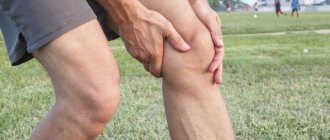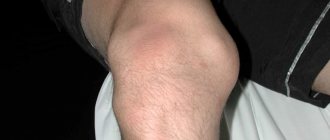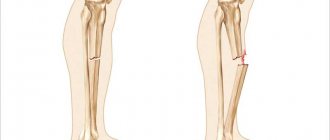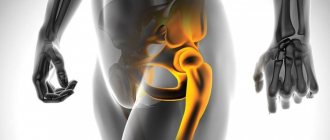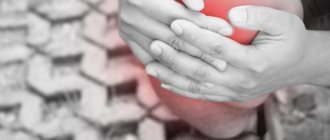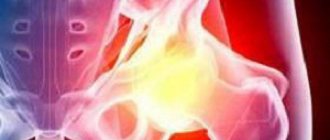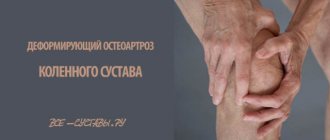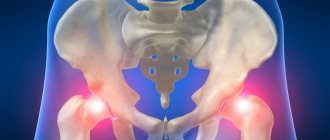Dislocation is a displacement of the joint surfaces and damage to the joint capsule. As a rule, this injury is accompanied by acute pain, due to which the victim is unable to make any movements with the injured limb. Dislocation is different in that although the bones are in the wrong position, their integrity is not compromised.
The human leg contains many joints, so it is quite vulnerable. In most cases, the knee joint or foot is damaged. But regardless of the type of injury, the victim must undergo treatment in a hospital setting.
Why is a dislocation dangerous?
So, when a dislocation occurs, the bones in the joint are displaced.
As a result, they may either not touch each other at all (this is called a complete dislocation), or they may only partially touch each other (this is called a subluxation).
The danger of such an injury is that not only the joint is damaged, but also the tissues that surround it: destruction of the nerve trunks is fraught with loss of sensitivity, in the worst case, a nerve rupture may occur; if blood vessels are damaged, the victim’s condition may be aggravated by significant blood loss. That is why you should immediately seek help from a qualified doctor, and while the victim is being taken to the hospital (or, alternatively, waiting for the ambulance to arrive), he needs first aid. But first you should find out what the symptoms of this injury are.
Important information! Injuries are not the only causes of dislocations. There is also a congenital dislocation, which occurs if the development of the articular cavities is disrupted in the fetus while still in the womb. This phenomenon is quite rare and occurs mainly in the hip joint.
Rehabilitation activities
The main methods of rehabilitation, including recovery after dislocation of the wrist and elbow joint in adults, include exercise therapy, massage and physiotherapy. Laser therapy, ultrasound, myoelectric stimulation, magnetic therapy and interference therapy are widely used as the latter.
By performing therapeutic exercises after a dislocation of the shoulder joint, you will quickly restore joint mobility, improve blood circulation and increase its flexibility. For the same purpose, different types of massage are prescribed during rehabilitation. Please note that after a joint dislocation, the recovery period is individual for each patient and requires regular supervision by an orthopedist and rehabilitation specialist, in some cases a neurologist, massage therapist and physiotherapist.
Prevention of dislocations can only be prevention of injuries or early diagnosis (professional examination for congenital pathology) in newborns. On our website you can familiarize yourself with the qualifications of specialists who advise in this area. You can make an appointment at any time convenient for you.
Related services: Orthopedics and traumatology Calling an ambulance
Main causes of dislocations
- As noted above, dislocation usually occurs due to indirect injuries. If, for example, a person falls on a bent leg, he may dislocate his hip, and if he falls on an outstretched arm, he will most likely dislocate the shoulder joint.
- Children under three years of age sometimes experience a “pull dislocation,” which is when the child trips while being held by the hand.
- Dislocation is also possible as a result of a sharp muscle contraction (for example, with a strong yawn, a person can dislocate the lower jaw).
- It is extremely rare that a dislocation occurs due to direct impact on the damaged area.
Special classification
The sequence for diagnosing a deviation involves the need to assign a certain status to the dislocation according to several classifications. All such injuries can be sorted according to:
- origin;
- degree of displacement;
- skin condition;
- statute of limitations.
There is no place for pre-medical support for newborns who have become victims of intrauterine anomalies. Instead, help lies in long-term therapy, which is beneficial in the early stages in most situations.
Also, emergency medical care will be useless if the visit was due to pathological displacement, which is caused by a chronic illness. It is most effective to use a summary of pre-medical rules for cases of traumatic injury to a leg or other part of the body.
Orthopedics has its own classification according to the degree of displacement of the bone structure:
- full;
- incomplete.
The second version is also called subluxation, since it involves the divergence of the ends of the joints not completely. Some contact area still remains. At the full stage, the articular ends of the arm diverge completely.
A quick examination of the problem area allows you to make an assessment of the skin. If signs of destabilization include a violation of tissue integrity, then this indicates an open type of dislocation. When the analogue is closed, the top layer remains unharmed.
But you should not assume that the second subtype of injury is safer. In fact, it poses a serious threat as it sometimes involves ruptured blood vessels. And with bleeding without an open wound surface, the average person usually cannot cope on his own.
The statute of limitations also affects the severity of the disease, so it was included in a separate classification. Fresh injuries cover a time interval of up to three days. Stale – from three days to two weeks. Outdated – terms higher than indicated. The latter option is especially characteristic of lesions of the shoulder joint.
But, regardless of what degree the lesion was assigned, it must be certified according to the latest special classification, which covers the division into the following groups:
- paralytic;
- complicated;
- habitual;
- irreducible.
The first point covers muscle paralysis that outweighs the antagonist muscles in strength.
A correctly diagnosed complicated variant helps in further development of therapy, as it allows one to identify complications such as nerve lesions and disorders of the main blood vessels. In the most dangerous scenario, symptoms indicate intra-articular or periarticular fractures.
As for the shoulder, he most often has to deal with the usual class. Its peculiarity lies in periodically repeated dislocation at the same point. This is often caused by anatomical changes due to a number of pathologies, as well as muscle weakness or problems with ligaments.
The irreducible analogue covers old injuries, which are almost always accompanied by penetration of tissue between the articular surfaces of the bone ends.
Symptoms of joint displacement
The main symptoms of a dislocation are: severe pain, limited movement, altered joint contours, swelling.
When you try to perform any movement, the pain only intensifies. Such an injury requires urgent medical treatment, but - and this is very important - only after a medical examination. You cannot try to straighten the joint on your own, since an accurate doctor’s opinion is required - the fact is that it could be a fracture, and in this case any manipulations can significantly worsen the situation.
Other symptoms include swelling and redness of the skin over the bruised joint, and less commonly, a hematoma. If the nerve is damaged, sensation may be lost.
Primary signs of dislocation (appear immediately after injury):
- when feeling the bruise, the patient feels severe pain;
- the functions of the entire injured limb were sharply limited.
Subsequent signs (identified upon examination):
- change in the contour of the injured joint;
- during manual examination, the head is in an unnatural position or is completely absent;
- change in limb length.
As a rule, dislocations of the fingers, hip joint, shoulders, knees, feet, lower jaw, and elbows occur.
Important information! The main difference between a dislocation and less dangerous injuries (bruises, sprains) is that all symptoms appear immediately after the injury, and do not increase gradually. For this reason, if you are not sure what kind of injury it is, then it is advisable to assume the worst and provide assistance, as in the case of a dislocation. And if it later turns out that there was only a sprain, then nothing bad will happen anyway. It is much more dangerous if the injury is underestimated.
The victim should receive medical assistance no later than three to four hours after the injury, since after this time the tissues will begin to swell and blood will accumulate in them, which may cause difficulties in the process of reduction. The victim can personally visit the hospital or arrive there in a sitting position (if the upper limb is dislocated). If a leg dislocation occurs, transportation should only be carried out in a lying position.
Video - How to recognize a dislocation
First aid for a sprain
Many people know that a dislocation is treated by reduction. But few people know that a non-specialist should not do this, since any careless actions can lead to aggravation of the injury; in more severe cases, the joint may completely collapse, and the victim will remain disabled.
First aid
includes the following steps.
- The first thing to do is immobilize the damaged joint.
He must remain in the position he was in after the incident. You should not straighten the limb, much less rotate it - the joint should be fixed with a splint (as in the case of a fracture). If the hip joint has been dislocated, then the person needs to be laid down and the healthy leg wrapped around the injured one with bandages; The victim should be transported using a rigid stretcher or something similar. - Do not apply warm compresses to the injury. To reduce pain, you will need a cold compress - a damp towel or a heating pad with ice. In addition, the victim can be given a painkiller - amidopyrine or analgin.
- If the damage is accompanied by a wound, then a sterile bandage must be applied to it.
- The person needs to be taken to the hospital as soon as possible, otherwise there may be complications during the reduction.
- When transporting yourself to the hospital, you need to ensure that the victim is as comfortable as possible and that the injured part of the body moves as little as possible.
Video - Assisting with a dislocation
Features of treatment
The treatment procedure begins with an x-ray examination, after which the doctor makes an accurate diagnosis.
Next, using anesthesia, the articular bones are reduced to their natural position.
After this, the joint must be completely immobilized, for which a plaster cast is applied to it until the damaged tissues heal.
Important information! If, after reduction, the victim still complains of tingling and pain in the damaged joint, it means that there is not enough blood flowing there as a result of the bandage being too tight. If pain is still felt after removing the bandage, you should immediately consult a doctor.
The reduction itself should be performed smoothly, without sudden movements. At the moment of reduction, a characteristic click should be heard, after a couple of minutes after which passive mobility will begin to be restored, and the joint itself will begin to take on the correct shape. Complete healing requires time (usually rehabilitation takes one month) and complete immobilization of the joint. All this time, the load should be minimal; if necessary, additional therapy is prescribed in the form of therapeutic exercises and physiotherapeutic procedures.
As a result, we note once again that the main thing in case of a dislocation is timely medical assistance. After all, after three to four hours, the bones will be difficult to set due to accumulated blood, and in the case of an old dislocation (three to four weeks), only surgical intervention will help the victim.
Diagnostics
After examining and palpating the damaged area, the traumatologist (namely, he deals with such injuries, including congenital dislocations of joints) will refer the patient for an x-ray. After confirming the diagnosis, the doctor can provide full specialized assistance, starting from eliminating the dislocation and ending with the necessary immobilization or fixation, supplemented, if necessary, with medication and restorative treatment. At the end of the immobilization period, a rehabilitation program is prescribed to restore movements and predict the outcome of treatment.
